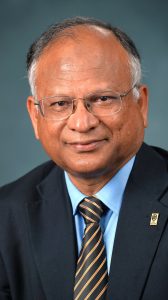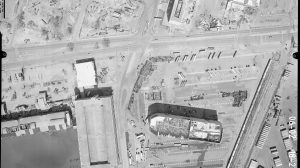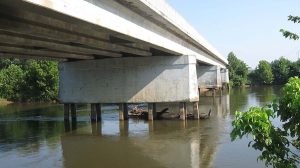Engineers at the University of Mississippi are at the forefront of a research collaboration that is helping solve infrastructure problems near and far.
UM scientists have partnered with Mississippi State University-led University Consortium for a National Center for Intermodal Transportation for Economic Competitiveness grant of $6.9 million from the U.S. Department of Transportation’s Research and Innovative Technology Administration. Other consortium universities include the University of Denver, Louisiana State University and Hampton University.
“The theme of NCITEC is to promote the development of an integrated, economically competitive, efficient, safe, secure and sustainable national intermodal transportation network by integrating all transportation modes for both freight and passenger mobility,” said Waheed Uddin, NCITEC associate director and UM professor of civil engineering. “Between 2012 and 2016, UM researchers conducted 13 research projects using a total grant of $1.26 million from NCITEC.”
Funded topics at UM include the global supply chain, NAFTA freight studies, highway-rail-waterway and intermodal integration, studies of highway bridge structures subject to truck traffic, scouring and floodwater impacts.
UM mechanical engineering professors Tyrus McCarty and Jagdish Sharman are the principal and co-principal investigators of the most innovative NCITEC project, “Energy Harvesting from Traffic Vibrations.”
“This project used nanocoated PTZ sensors to enhance energy outputs from traffic vibrations,” McCarty said. “The implications are huge, once implemented in the field in rural areas. It can provide energy to illuminate dark areas on highways, including shoulder edges and rail-highway crossings, for increasing safety of auto and rail traffic and reducing carbon dioxide emissions.”
Uddin and Mustafa Altinakar are co-PIs on another NCITEC project, “Extreme flood simulations and flood impacts on structural integrity of transportation infrastructure assets.” Investigators of four other projects on structural assessment of bridges include civil engineering professors Elizabeth Ervin and Chris Mullen, Charles Swann of the Mississippi Mineral Resources Institute and researchers at the university’s National Center for Physical Acoustics.
“Dr. Altinakar’s computer flood simulations results were the backbone of new discoveries by my two Ph.D. students in civil engineering who advanced the knowledge of flood impacts on infrastructure and communities,” Uddin said. “Alper Durmus computed hydrodynamic forces using Dr. Altinakar’s computational flood modeling results.”
Durmus developed a detailed 3-D finite element computer model of a U.S. 51 concrete bridge subjected to the lateral extreme floodwater force and discovered the vulnerability of bridge superstructure (girders and deck). Uddin’s previous research showed that this failure mechanism was observed in the destruction of bridges during 2005 Hurricane Katrina on the Mississippi Gulf Coast and 2011 Hurricane Irene on the East Coast.
“Under my guidance, Alper is developing guidelines using National Bridge Inventory System database to identify such vulnerable bridges crossing over water bodies so that these can be prioritized for hardening to enhance flood resilience,” Uddin said.
Quang Nguyen also used Altinakar’s two-dimensional flood modeling results to evaluate a one-dimensional flood simulation program developed by U.S. Army ERDC Hydraulics Lab using shuttle radar-based terrain elevation models available worldwide. Nnguyen implemented this framework for selected port cities in Mississippi and Vietnam.
“Quang has also formulated and implemented NOAA’s recommended sea-level rise predictions associated with climate impacts for inundation studies in Miami and Vietnam,” Uddin said. “He further developed a methodology under my guidance to simulate extreme tsunami using 2011 Fukushima tsunami wave surge data to evaluate the extent of submerged coastal land and impacts on affected population.”
Kristin Swain of the Meek School of Journalism and New Media conducted her project, “Risk framing of U.S. intermodal transportation toxic spills in news and social media.” Her research shows that 161,079 toxic spills in the U.S., reported between 2003 and 2012, involving air, rail and waterways exceeded $701 billion in cleanup and mitigation costs.
Swain’s news media analysis found that 99.48 percent of the 5,555 most serious spills during transportation of hazardous materials received no news coverage.
Uddin is PI for “Intermodal integration of highway-rail and highway-waterway corridors for economically viable supply chain.” Other co-PIs from the University of Denver and Clemson University have their own NCITEC projects on this topic.
“This project demonstrated the use of geospatial analysis to identify feasible corridors on maps generated from highway and rail map database,” Uddin said. “Using mathematical optimization for minimizing shipping costs, the least cost corridors were selected for several intermodal freight integration cases, including NAFTA routes. The research showed substantial reduction in transportation related-carbon dioxide emissions.”
The methodology developed in this project is timely because the current USDOT funding authorization of FAST Act recommends calculating carbon emissions as a part of transportation project planning. Uddin has partnered with two different University Transportation Center consortia that submitted new proposed projects on efficient freight mobility.
Two graduate students carried out most of the research tasks. Seth Cobb completed his master’s thesis in August 2015. Doctoral student Zul Fahmi conducted comprehensive commodity research and geospatial mapping of carbon emissions on NAFTA corridors.
The white paper on another project, “Gulf Coast Rail Passenger Service Revival,” is already being used as a reference in rail studies for connecting Dallas-Fort Worth with Atlanta through Mississippi.
Investigators represent the university’s civil, electrical and mechanical engineering departments of the School of Engineering, National Center for Computational Hydroscience and Engineering, Mississippi Minerals Research Institute, National Center for Physical Acoustics, Meek School of Journalism and New Media, and Trent Lott Institute of Public Policy Leadership.
“The primary research accomplishments include brief fact sheets on key research results of each funded project for distribution and web access,” Uddin said. “We’ve seen the development of transportation visualization products based on geospatial analysis and computational modeling.”
Research funding has strengthened the workforce and enhanced undergraduate and graduate courses. Ten master’s students and two doctoral students have completed their degrees thus far and two doctoral students will complete in 2016. One doctoral student on a CAIT/NCCHE project received the 2013 NCITEC Student of the Year award.
Key project investigators presented at regional and national conferences and published papers in journals and conference proceedings. Several YouTube videos and Slide Share posts disseminate the research results of the UM projects to the transportation community and agencies in the state, region and worldwide.


